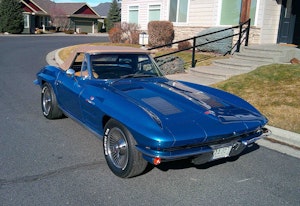Media | Articles
Detroit’s newest automaker, Bollinger, has big ambitions
At an event held around the corner from its headquarters in Ferndale, Michigan, just north of Detroit, EV startup Bollinger Motors revealed beta prototypes of its battery-powered 600+ horsepower, four-wheel-drive B1 SUV and B2 pickup. Unlike the light duty electric pickups being developed by Rivian, Ford, GM, and Workhorse, the B1 and B2 are based on a purpose-built Class 3 truck platform. Bollinger describes them as the world’s first all-electric off-road and on-road trucks.
The all-aluminum trucks have a structure similar to that of the original XJ Cherokee from Jeep, essentially a unibody welded to a frame, so they should be durable. So durable, in fact, that the company says it is not looking for repeat business; it wants to sell you one “forever truck” that will last you the rest of your life.
Powered by 120-kWh lithium-ion battery packs mounted to the trucks’ undersides and a permanent magnet electric motor on each axle, each truck has a combined 614 horsepower with 668 lb-ft of torque. Each motor has its own two-speed gearbox, so the trucks are capable of 100-mph top speeds, while still being able to crawl at low speed when off-road. They have 15 inches of ground clearance, serious approach and exit angles, geared wheel hubs with offset axles that allow 10 inches of wheel travel, and a hydraulic suspension that can raise or lower the vehicles five inches in each direction. A virtual center differential controls the vehicles’ four-wheel-drive system via software.
The Bollinger trucks ride on eight-lug, styled steel, 17-inch wheels mounted with LT285/70/R17 tires. Underneath, you’ll find four-wheel disc brakes with 11.75-inch ventilated rotors, mounted inboard of the suspension.
Marketplace
Buy and sell classics with confidence
20190927132900)
20190927132918)
20190927132951)
Rated with a 5200-pound payload capacity and 7500-pound towing capacity, with utilitarian but handsome styling, these are definitely work trucks. The battery-powered trucks ironically obviate the need for battery-powered tools. An onboard inverter supplies a dozen 110-volt AC outlets situated in the bed and front trunk, under the dashboard, and set into the passenger side front fender, opposite from the charging port. The utilitarian styling is carried through to the interior, which is mostly black painted steel, with some minimalist wooden trim, stained black, made of oak salvaged from Detroit industrial sites. Removable glass panels fill the roofs, and the doors, windshield, and the side windows are also removable for al fresco driving.
There is no radiator grille, at least where you’d expect to see one up front, but there are two radiators for the battery cooling system mounted below grilles on the top of the front fenders.
Despite the computer-controlled drivetrain, the B1 and B2 are very much analog devices. The non-power windows slide open (let’s hope they are more watertight than similar windows that came on the original Austin Mini) and the doors lock with levers, not switches. That computer-controlled drivetrain is operated with an old-fashioned steering column-mounted gear shift lever with a repro vintage PRNDLL2 indicator that looks like it was sourced from a mid-’60s General Motors product.
While the pickup bed can handle a 4×8-foot sheet of plywood or drywall laying flat, both vehicles have a novel, patented pass-through door system that will let you carry dimension lumber as long as 13 feet in the SUV and 16 feet in the pickup, or even longer if you open up the tailgate and drop-down front panel. The pass-through is tall enough and wide enough to accommodate a telephone pole if needed.
20190927133108)
The firm was founded by Robert Bollinger, who was unhappy with the conventional trucks he was using on his farm and decided in 2015 to “reinvent trucks, not just electrify them.” Bollinger Motors is currently self-financed by its namesake, who had a successful career in the hair care industry. As a youth, Bollinger wanted to become a car designer and now he has the means to live out his dream. Now that the beta prototypes are completed, the startup will have a round of funding from potential investors.
Initial production is planned for 1000 units annually combined for both vehicles, though Bollinger Motors chief engineer Karl Hacken indicated that the design was scaleable should demand call for greater production. Bob Bollinger told Hagerty that he hopes to decide on the location of a Detroit area assembly plant by the end of the year. Production is planned to begin sometime in 2021.
The trucks are designed and engineered to be street-legal worldwide. Initial markets for the Bollinger trucks will be Europe, the Mideast, and North America. Other markets will be considered as the project moves forward. At the current time, Bollinger has no plans to sell the B1 and B2 in China.
No pricing has been announced yet, we’ll find that out closer to production, but based on the production figures planned and some off-the-record comments, you can expect the Bollinger trucks to be into the six-figure range. It’s also a safe prediction that at least some Bollinger buyers will have had a Hummer H1 in their automotive portfolio at one time or another. If you think that EV enthusiasts and Hummer owners create a Venn diagram that has no overlap, just remember that Arnold Schwarzenegger drives an H1 converted to battery power.
20190927132839)








20190927133053)
20190927133118)
20190927133127)
20190927133139)
20190927133149)
20190927132845)
20190927132850)
20190927132855)
20190927132906)
20190927132912)
20190927132924)
20190927132930)
20190927132935)
20190927132941)
20190927132956)
20190927133002)

